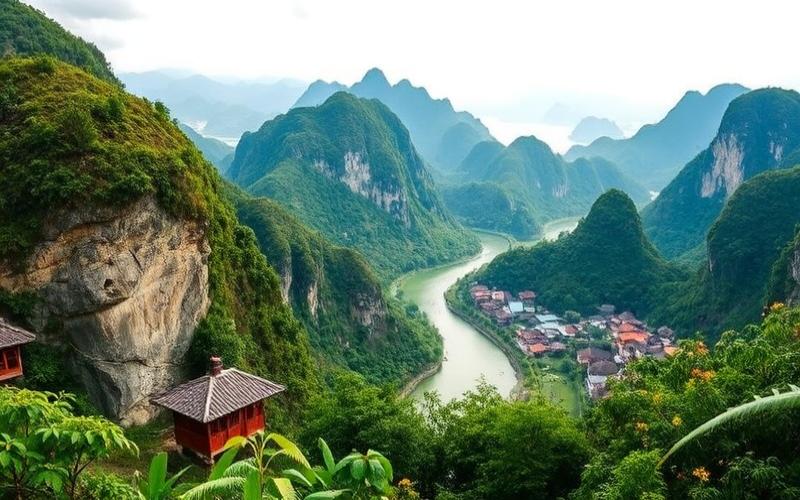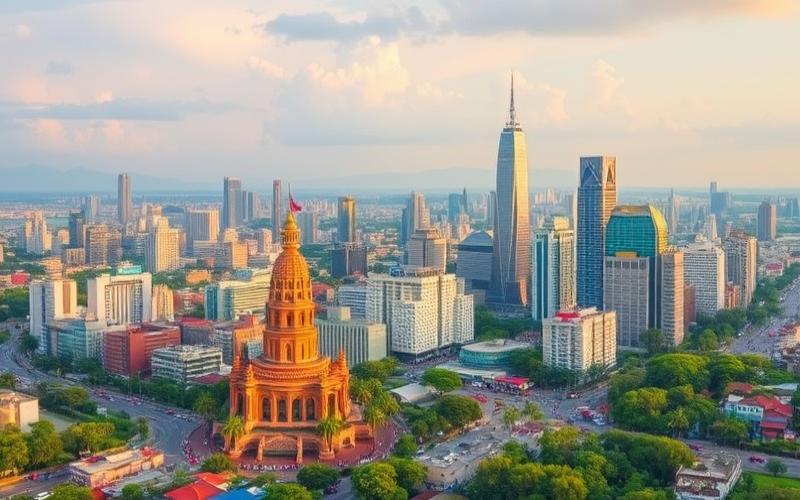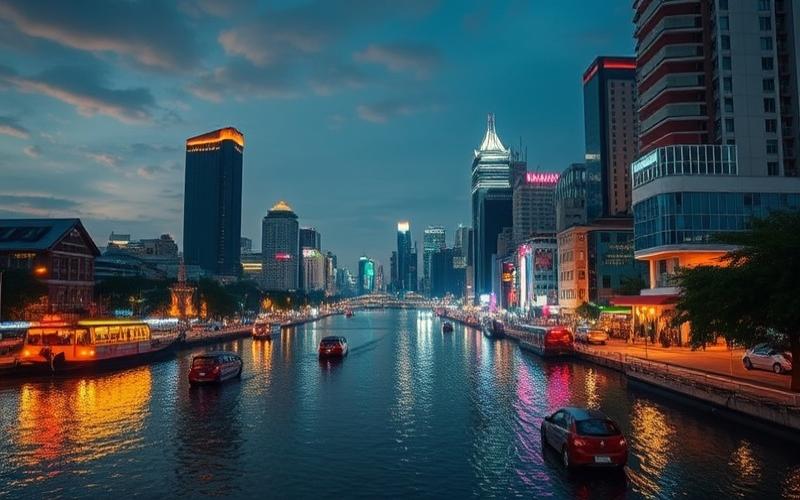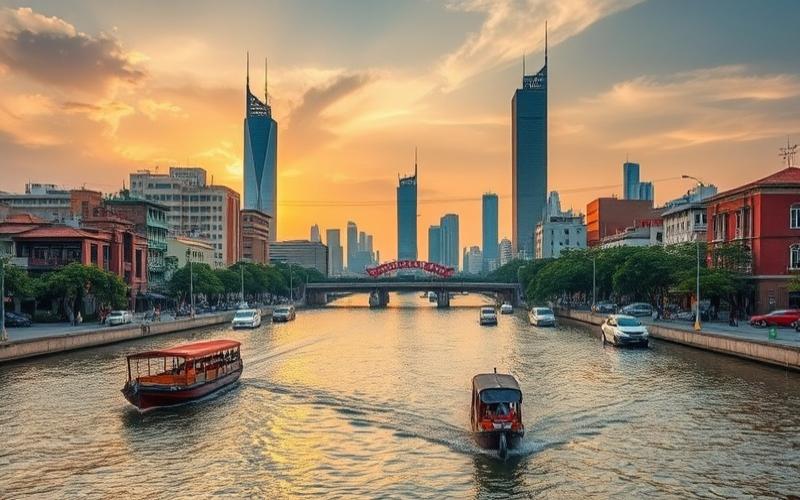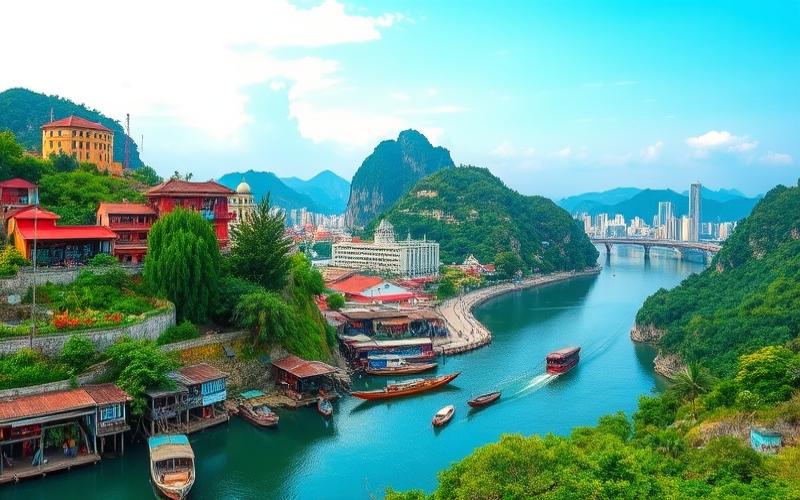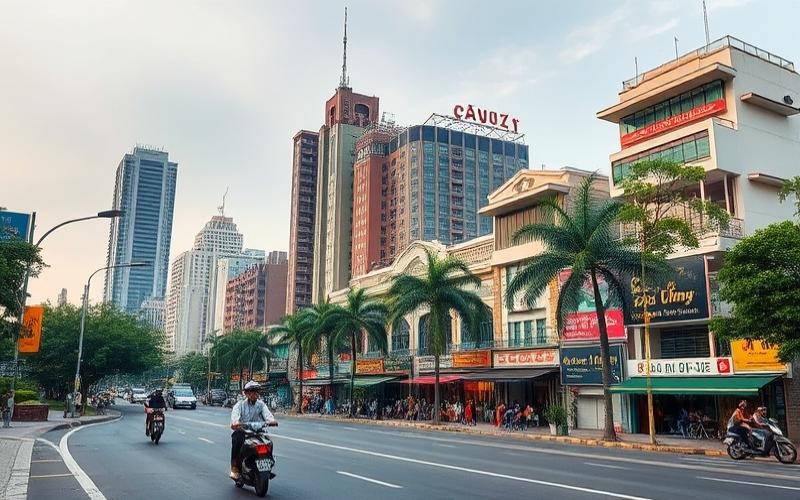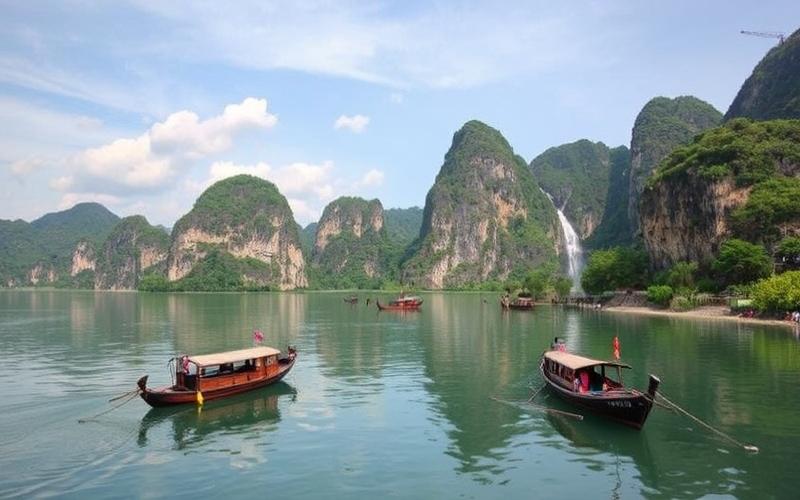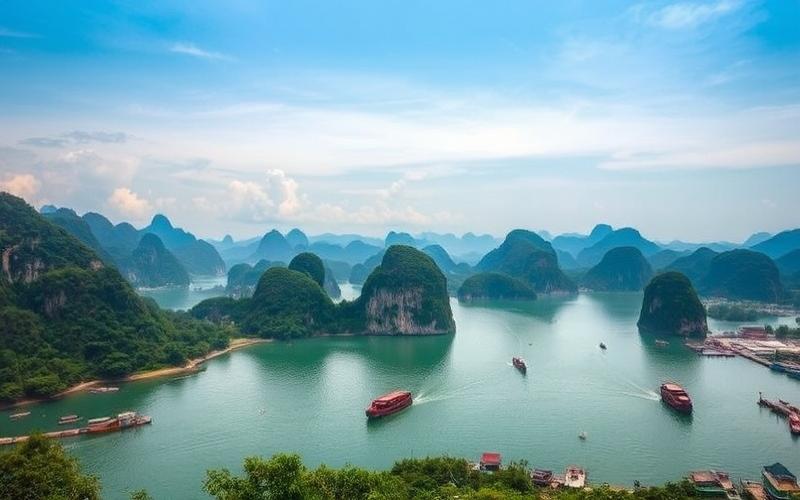
 Published on and written by Cyril Jarnias
Published on and written by Cyril Jarnias
Vietnam, with its rapid economic growth and favorable regulatory framework, is emerging as a prime destination for investors seeking returns in commercial real estate. At the heart of this dynamic, Ho Chi Minh City and Hanoi stand out with their vibrant urban development, offering unprecedented opportunities in sectors such as offices, shopping centers, and hospitality.
As the country continues its economic transition and attracts more international businesses, improvements in transportation infrastructure and rising local purchasing power enhance the appeal of the real estate market. Adapting to the unique characteristics of the Vietnamese market while anticipating emerging trends can enable investors to capitalize on exceptional growth potential in this booming region.
Exploring the Potential of Commercial Real Estate in Vietnam
The commercial real estate market in Vietnam is experiencing sustained momentum, driven by economic growth, rapid urbanization, and favorable government policies. Key high-growth sectors include retail, offices, logistics warehouses (dark stores), and hospitality infrastructure.
| Sector | Trends & Outlook |
| Retail | Strong post-Covid recovery, sales up (+9% in 2024). Expansion of national/international chains in urban centers. Conversion of traditional stores into dark stores to meet e-commerce demand. |
| Offices | Increased demand for modern spaces in Hanoi and Ho Chi Minh City CBDs; numerous new projects driven by local/foreign investors. |
| Logistics Warehouses | Targeted rent increases for premises suited to urban delivery; conversion of traditional commercial spaces into logistics platforms (dark stores), especially in major cities. |
| Hospitality Infrastructure | Proliferation of high-end projects in coastal areas (Phu Quoc, Ha Long); diversification into new segments beyond traditional tourism due to growing influx of foreign and domestic investors. |
Impact of Economic Reforms and Public Policies:
- The Vietnamese government has implemented several measures to enhance real estate market transparency, simplifying certain administrative procedures related to foreign investment.
- Public initiatives focused on connected urban development (interregional transport, road infrastructure) strongly boost land values around economic hubs.
- Favorable tax policies continue to attract foreign capital across all commercial segments.
Major Economic Hubs:
- Ho Chi Minh City: Market driver with strong growth in the tertiary sector; accelerated transformation of the commercial landscape due to e-commerce/urban logistics.
- Hanoi: Consolidation around the CBD with persistent demand for high-end modern offices and centralized retail.
- Other emerging dynamic hubs: Da Nang on the central coast, Phu Quoc (hospitality/boutique villas).
Key Factors Driving This Attractiveness:
- Rapid urbanization
- Young demographic growth
- Massive development of e-commerce
- Relative political stability
Major Challenges Faced:
- Persistent regulatory complexity despite recent simplifications
- Risks related to global macroeconomic fluctuations (inflation/imports)
- Localized lack of infrastructure suited to new commercial/logistical forms
- Increased land pressure due to competition between residential/commercial uses
Recent Success Examples:
- Vin Group has successfully multiplied its multi-segment investments nationwide.
- In Ho Chi Minh City, effective conversion of former physical stores into dark stores has substantially increased rental profitability.
- On the northern and southern coasts, flourishing development of boutique hotel villas by Sun Group or FLC Group.
Forecasts:
| Expected Growth | Short Term | Long Term |
| Total Value | ~$19 Bn by end of 2024 | >$39 Bn by 2030 horizon |
| Estimated CAGR | +15% / year | Remains high if macro stability |
Key Takeaway: Vietnamese commercial real estate offers exceptional potential but requires ongoing regulatory vigilance and strategic adaptation to rapid changes driven by digitalization and contemporary urban evolution.
Good to Know:
Commercial real estate in Vietnam shows promising potential thanks to significant growth in the retail, office, logistics warehouse, and hospitality infrastructure sectors. Government policies aimed at stimulating investment and economic reforms have strengthened the market’s appeal, with cities like Ho Chi Minh City and Hanoi as major economic centers. However, investors must navigate a complex regulatory environment and assess inherent market risks. Recent examples include successful investments by local and foreign companies, such as Ikea’s expansion in logistics infrastructure. Growing demand for modern commercial spaces, fueled by a rapidly developing economy, offers robust growth prospects in the short and long term despite regulatory challenges.
Diversity of Available Commercial Properties
Commercial real estate in Vietnam is characterized by a diversity of properties, adapted to the economy’s rapid growth and the evolving needs of domestic and international businesses. The main asset types are:
| Property Type | Description |
|---|---|
| Offices | Office buildings (Grade A, B, C), located in central and peripheral districts |
| Shopping Centers | Large modern malls, commercial galleries integrated into mixed-use projects |
| Warehouses/Logistics | Industrial parks, warehouses dedicated to urban or regional logistics |
| Hotels/Hospitality | High-end or budget urban hotels, resorts in tourist areas |
Geographical distribution is dominated by major metropolises:
- Hanoi: Strong demand for modern offices; sustained development in the hospitality and retail sectors
- Ho Chi Minh City: Main economic hub with a mature market for all categories (Grade A-C offices, international shopping centers)
- Da Nang: Rapid growth in the hospitality/tourism sector; new logistics warehouses linked to the port
Evolution of Market Trends:
- Progressive upscaling in the office segment (Grade A projects) with increased supply outside central districts.
- Accelerated development of logistics warehouses driven by e-commerce.
- Proliferation of mixed-use projects integrating retail/offices/hospitality.
- Trend towards competitive rents to attract international tenants.
Government policies promote development through:
- Opening to foreign direct investment (FDI), which particularly boosts industrial logistics and hospitality.
- Tax incentives in certain key economic zones.
Growing urbanization intensifies demand around major axes; globalization attracts international brands requiring high standards in real estate infrastructure.
Opportunities for Investors:
Summary list:
- Profitability:
- Grade A offices located downtown offer stable returns but high prices
- Warehouses/logistics show strong potential thanks to the e-commerce boom
- Well-located hotels in tourist markets show high seasonality but strong margins
- Risks:
- Volatility due to occasional saturation in certain high-end segments
- Dependence on global economic conditions/international tourism
- Long-term Potential:
- Sustained expected growth (>10% annually) thanks to continued urbanization and FDI influx
- Increasing diversification towards secondary cities/regional development
| Segment | Profitability | Risk | Long-term Growth Potential |
|---|---|---|---|
| Offices | High (downtown) | Moderate on prime locations | Good if urbanization continues |
| Retail | Variable | High facing mall/online competition | Stable in large cities |
| Logistics | Rising | Moderate | Very strong via e-commerce/industry |
| Hospitality | Seasonal | Sensitive to external shocks | High on tourist axes |
The overall picture reflects a dynamic market where geographical and sectoral diversification allows balancing risks/opportunities according to investor profiles.
Good to Know:
The commercial real estate market in Vietnam offers impressive diversity, including modern offices, dynamic shopping centers, efficient logistics warehouses, and welcoming hotels. The rapid evolution of major cities such as Hanoi, Ho Chi Minh City, and Da Nang, boosted by urbanization and globalization, is transforming the real estate landscape into a mosaic of opportunities. The arrival of foreign investments and supportive government policies foster this diversification, making these niches attractive to investors. Offices in economic hubs like Hanoi are often sought for their profitability, while warehouses, increasingly crucial in an e-commerce-driven economy, show certain growth potential. Risks exist, but a well-directed investment can thrive thanks to Vietnam’s economic growth, offering long-term return on investment prospects.
Analyzing Profitability and Inherent Risks
Analysis of Investment Profitability in Vietnamese Commercial Real Estate
Return on Investment (ROI) and Rental Rates
Yield rates in Vietnamese commercial real estate generally range between 6% and 9% depending on the property type (offices, retail, commerce).
Occupancy rates for commercial premises in major cities like Ho Chi Minh City and Hanoi remain high, often exceeding 90% for quality properties, supported by demographic growth, the rise of e-commerce, and the arrival of major international brands.
Rents tend to increase, particularly for premium assets, due to sustained demand and limited supply in certain segments.
Economic Growth and Sector Outlook
Vietnam shows robust economic growth: in 2024, retail sales grew by 9% year-on-year, reaching approximately $250 billion. Forecasts for 2025 project a retail market of $350 billion, nearly 59% of the state’s total budget.
Structural factors: young population, expanding middle class, tourism development, favorable government policies, and growing foreign investments.
The real estate sector in Ho Chi Minh City recorded growth of 6.7% in Q3 2024, with an expected increase in apartment prices of 15 to 20% in 2025.
Potential Risks
Political Instability: Vietnam benefits from relative political stability, but lack of transparency, administrative delays, and regulatory changes can hinder foreign investment.
Exchange Rate Fluctuations: Volatility of the Vietnamese dong against the US dollar or euro can impact real profitability for international investors, especially during global instability.
Local Regulations: Restrictions on land ownership, slow licensing processes, and shortage of new projects sometimes limit supply and create uncertainties for investors.
Comparison with Other Emerging Markets
| Criterion | Vietnam | Thailand | Indonesia | Philippines |
| Yield Rate (ROI) | 6-9% | 5-7% | 7-9% | 6-8% |
| GDP Growth 2024-2025 | ~6% | ~3% | ~5% | ~5.5% |
| Office Occupancy Rate | >90% | ~85% | ~80% | ~85% |
| Major Risks | Regulations, exchange | Pol., exchange | Pol., exchange | Pol., regul. |
Case Studies and Concrete Examples
Ho Chi Minh City 2024-2025: The premium office market shows high occupancy rates (>92%), despite a shortage of new projects, leading to continuous increases in rents and sale prices. However, some peripheral districts suffer from oversupply and lower yields.
Retail and E-commerce: The arrival of major international chains and rapid e-commerce development stimulate demand for modern commercial spaces, particularly in city centers and tourist areas.
Regional Comparison: Compared to Bangkok or Jakarta, Ho Chi Minh City and Hanoi offer faster growth but higher regulatory and land volatility, which may limit appetite from foreign institutional investors.
Opportunities and Threats
Opportunities:
- Strong growth in domestic consumption.
- Rapid urbanization and tourism development.
- Macroeconomic stability and increased integration into global value chains.
Threats:
- Lack of transparency and administrative complexity.
- Dong volatility and external macroeconomic risks.
- Risk of overheating in certain segments (luxury offices, premium retail) and shortage in others (commercial housing, quality assets).
Summary Table of Key Factors
| Opportunities | Threats |
| Middle-class growth | Regulatory instability |
| E-commerce boom | Exchange fluctuations |
| Increased foreign demand | Shortage of new projects |
| Government support | Risk of localized oversupply |
⟦Commercial real estate in Vietnam offers high yield potential driven by economic growth, but remains exposed to structural and regulatory risks higher than other Asian emerging markets.⟧
Good to Know:
Analyzing the profitability of investments in Vietnamese commercial real estate reveals that the country offers attractive return rates, supported by robust economic growth and a booming real estate market, with steadily increasing rental rates. However, it is crucial to consider potential risks such as political instability, exchange rate fluctuations that can impact profits, and local regulations that may introduce unforeseen obstacles. Comparing these conditions to other emerging markets, Vietnam stands out with stronger economic stability, though it is comparable to countries like Indonesia in terms of regulatory risk. For example, the entry of major international groups into the market, such as CapitaLand and Keppel Land, illustrates the interesting yield opportunities, but also the importance of navigating local market complexities to maximize gains and minimize threats.
Current and Future Trends in the Vietnamese Real Estate Market
Main Economic and Political Factors Impacting the Vietnamese Real Estate Market
- Sustained Economic Growth: Vietnam shows one of the fastest economic growth rates in Asia, with GDP projected at $630.5 billion by 2026.
- Rising Foreign Investments (FDI): The country massively attracts foreign direct investment thanks to its macroeconomic stability and expanding middle class.
- Recent Regulatory Reforms:
- New legislation on land and housing aimed at enhancing market transparency.
- Reduced borrowing costs to stimulate access to real estate credit.
- Implementation of the national urban planning program (Resolution No. 148/NQ-CP), accelerating urbanization and modernizing land management.
Current Trends in the Commercial Real Estate Market
List of Major Evolutions:
- Rapid Urbanization: Urbanization rate expected >45% in 2025, >50% by 2030. Significant migration to large cities, increasing demand for all types of urban real estate.
- Widespread Price Increases in key areas (Hanoi, Ho Chi Minh City), driven by strong residential and commercial demand.
- Growth in Industrial/Logistics Segment:
- Notable expansion of logistics warehouses driven by the rise of e-commerce and regional industrial development.
- Increased demand for modern industrial parks adapted to international standards.
| Segment | Recent Trends | Driving Factors |
|---|---|---|
| Offices | Stability/rent increases | FDI, economy tertiarization |
| Shopping Centers | Post-pandemic recovery | Government stimulus & consumption |
| Industrial Spaces | Strong growth | E-commerce, manufacturing industry |
| Hospitality/Tourism | Gradual restart | Return of international tourist flows |
Other Notable Points:
- Digital Transformation: Players adapt their models to new digital habits (flexible offices/co-working; hybrid retail).
- E-commerce strongly stimulates demand for modern logistics.
Future Projections and Expert Perspectives
Main Forecasts:
- Expected growth exceeding +12%/year in the overall market until 2027. Estimated size: nearly $48 billion by end of 2024.
- Segments with the strongest potential:
- Industrial/Logistics real estate
- Affordable housing suited to a growing middle class
- Premium commercial spaces in major metropolises
Main Challenges/Opportunities for Investors:
- Opportunities:
- Attractive returns on new or renovated assets
- Geographical diversification facilitated by major national infrastructure projects
- Rapid digitalization offering competitive advantages to pioneers
- Challenges:
- Possible regulatory volatility during recent legislative implementations
- Increased international competition in promising segments (especially logistics)
- Risks related to global slowdown or occasional regional instability
Statistical Data & Recent Analyses
| Key Indicator | Value / Recent Evolution |
|---|---|
| Urban Population | ~45% expected end 2025 |
| Real Estate Market Size | ~$47.6 Bn (forecast end ’24) |
| Annual Growth | >12% CAGR until ’27 |
| Retail Sales Volume Q4’24 | +9.3% vs Q4’23 |
Analyses converge towards sustained dynamism in Vietnamese real estate, driven by intense urbanization, a favorable political environment – but requiring vigilance regarding regulatory changes – as well as the structural impact of accelerated digitalization.
Good to Know:
The Vietnamese real estate market is currently influenced by sustained economic growth and favorable policy reforms, such as the relaxation of foreign ownership laws. The government also emphasizes infrastructure development, catalyzing urbanization and growing demand for commercial spaces, offices, and industrial facilities. With the rapid emergence of E-commerce, logistics spaces are becoming particularly sought after. According to the latest World Bank data, commercial real estate prices have recently shown an average annual increase of 5%, while demand for shopping centers and offices in major cities like Hanoi and Ho Chi Minh City continues to grow. Experts predict this momentum will continue, highlighting that retail and industrial segments will offer the greatest growth potential in the coming years. However, investors must remain vigilant against potential challenges related to regulation and market saturation.
Disclaimer: The information provided on this website is for informational purposes only and does not constitute financial, legal, or professional advice. We encourage you to consult qualified experts before making any investment, real estate, or expatriation decisions. Although we strive to maintain up-to-date and accurate information, we do not guarantee the completeness, accuracy, or timeliness of the proposed content. As investment and expatriation involve risks, we disclaim any liability for potential losses or damages arising from the use of this site. Your use of this site confirms your acceptance of these terms and your understanding of the associated risks.




